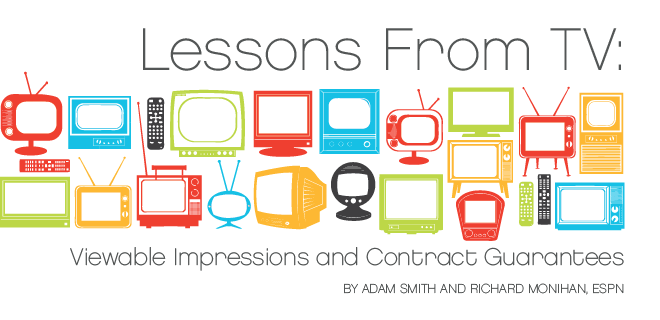
The frustrations of the world of digital media operations are many, though assumptions about its preeminent position for highly qualitative and accountable messaging are rarely questioned. Yet if the digital world is so great with respect to accountable and qualitative measurement, why do we have so many issues compared to broadcast and cable TV?
Consider discrepancies in billing. In a recent webinar offered by the IAB on viewable impressions, it was suggested viewable impressions can reduce discrepancies. The costs associated with chasing down a $50 line item discrepancy (let alone a smaller one) typically exceed the revenue saved by fixing the discrepancy. As an industry, we put in massive working hours to resolve discrepancies for one reason – preserving the image of accountability at a micro level.
We’ve sold our industry on the concept that digital is more precise, more accurate, and more accountable. As a result we go to great lengths to justify this claim. So advertisers ask for billing based on actual numbers, based on exact delivery by line items. Even with the presumed “precision,” advertisers are only paying for impressions delivered, not an assuredness that their ads are capable of being seen.
This point is changing with the introduction of the viewable impression. Standards are evolving and once new pricing metrics are determined and put in place, viewable impressions will be the future. This shift to more accountability is laudable, but shines a light on larger questions of accuracy.
Switching to viewable impressions represents an opportunity to deal with some of these questions. Since viewable impressions are a step closer to TV in terms of how they are being measured and managed, why not adopt some of TV’s more beneficial behaviors to reduce digital’s operational friction?
Contracted Value
TV may be an old medium, but has practices which make a tremendous amount of sense and could provide the digital industry a chance to streamline operations and increase the profitability of both publishers and agencies. Vastly reducing discrepancy issues can free up resources to pursue more productive activities.
A simple solution is via contract guarantees and billing on contracted impressions. The only assuredness a line-item guarantee provides an advertiser is on payment of that portion of impressions which are delivered on a particular placement. As a result, shortfalls on a particular line item or in a particular month are usually not offset by overdelivery elsewhere.
Between added value, and overdelivery on sponsorships and fixed placements, advertisers often come out far ahead in eCPM vs. CPM delivery. Contract guarantees would alter the actual guarantee measure, but not the overdelivery potential, dramatically.
Since systems don’t communicate perfectly, or too many manual inputs take place, or systems report differences (as they often do) in delivery, discrepancies mount. Publishers and agencies alike face massive costs pursuing many small line item discrepancies. At the agency, costs are multiplied many times over by the number of sites they deal with.
What value do we derive from the pursuit of all these discrepancies, and what value do we add to the advertiser? None.
With a contract guarantee, advertisers are not shortchanged, and can still benefit from overdelivery. While a line item may underdeliver, the focus is on meeting the total revenue value contracted, and meeting or exceeding the guaranteed contract CPM. This can be done by agreeing that monthly revenue overdeliveries can offset monthly underdeliveries, or underdeliveries on line items can be offset by overdeliveries of similar or greater CPM value. Essentially, advertisers will get equal or better inventory to offset shortfalls.
No Complete Solution
This change won’t eliminate discrepancies, but will substantially reduce costs resolving them. Contract Guarantees mean there is a minimal level of overall performance which the publisher must meet or exceed. The discrepancy issue is reduced by recognizing, as in TV, billing should be based on a level of contracted impressions, with the inherent acceptance on the part of the publisher to deliver on that guarantee.
This turns many accepted practices utilized by agencies on their head. But if we adopt these practices as an industry, money and resources will free up to help the industry grow faster and actually become much more accountable.
 |
Macro-level changes are coming, and you can sieze the opportunities that follow at OPS NY. This event will bring together digital advertising leaders and ops professionals to discuss a rapidly evolving landscape and develop strategies for monetization. Register today for OPS NY which will be held Oct. 4, 2012. |
 Adam Smith is the Sr. Director, Advertising Operations and Technology at ESPN. Mr. Smith oversees the digital ad operations group and digital advertising platforms at ESPN, supporting ESPN branded sites and applications worldwide including ESPN.com, WatchESPN.com, ESPNDeportes.com, ESPNcricinfo.com, ESPNFC.com, ESPNF1.com, ESPNscrum.com, along with ESPN’s mobile applications. Earlier in his career, Mr. Smith worked in several roles across digital media and technology at Disney Internet Group in Seattle. He started his career as a software development engineer and program manager at Microsoft. He currently lives in Brooklyn, NY.
Adam Smith is the Sr. Director, Advertising Operations and Technology at ESPN. Mr. Smith oversees the digital ad operations group and digital advertising platforms at ESPN, supporting ESPN branded sites and applications worldwide including ESPN.com, WatchESPN.com, ESPNDeportes.com, ESPNcricinfo.com, ESPNFC.com, ESPNF1.com, ESPNscrum.com, along with ESPN’s mobile applications. Earlier in his career, Mr. Smith worked in several roles across digital media and technology at Disney Internet Group in Seattle. He started his career as a software development engineer and program manager at Microsoft. He currently lives in Brooklyn, NY.